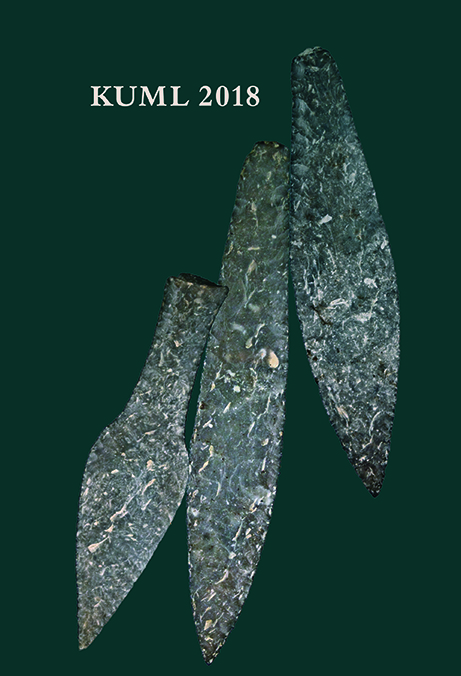Hellegård
A cemetery in southern Funen containing weapons and tools from the decades around the birth of Christ
DOI:
https://doi.org/10.7146/kuml.v67i67.110840Keywords:
hellegård, cemetary, southern funen, early iron ageAbstract
Hellegård
A cemetery in southern Funen containing weapons and tools from the decades around the birth of Christ
The site of Hellegård near Svendborg was excavated in 2011, and the excavations uncovered traces of human activities dating from the Neolithic to the Late Germanic Iron Age. One of the major features was a settlement occupied from the beginning of the Pre-Roman Iron Age until the middle of the Roman Iron Age (c. 500 BC - AD 200). A small cemetery dating from just after the birth of Christ, found associated with the settlement, is the main focus of this article (figs. 1-2).
The cemetery contained 11 cremation graves furnished with pottery and a variety of iron objects. Fragments of pots were found in ten graves, either in the form of a few potsherds from one or two vessels, or numerous remains from several vessels. None of the vessels was preserved in one piece, and it is very likely that the sherds were placed in the graves as pars pro toto offerings. The vessels were either large examples with a single handle or smaller ones, such as cups with or without handles and a footed beaker (fig. 3).
Weapons were found in three graves. A long, slender single-edged sword was found in grave A2485, together with a spearhead of Ilkjær type 22 Hunn, a shield boss of type 1 and probably a shield-grip fitting of type 1. Grave A2484 also contained a shield boss of type 1, in combination with a shield-grip fitting with circular terminals. In grave A2486, there was a combination of a shield boss and a spearhead of Ilkjær’s type 3. The weapons date the graves to around the birth of Christ and all are common types on Funen (figs. 4-7, 15).
Knives are one of the commonest types of grave goods during the Iron Age. The Hellegård knives are of four types, with the crescent-shaped type and the type with concave back being considered especially useful for leatherworking. One of the knives was ornamented (fig. 8). One of the two buckles found is of a type that is especially common to the south of Denmark (fig. 9). Graves A2485 and A2486 each contained a pair of shears (fig. 10), of a size that identifies them as being eminently suited for textile production and shearing.
While all the above-mentioned items are quite common finds on Funen, and in Denmark in general, the two pairs of tongs from A2485 are quite unusual (fig. 11). Only 12 tongs have been found in Denmark to date, and a couple of parallel finds are discussed (fig. 12). An iron rod with partly-folded terminals was also found in grave A2485. This is interpreted as a carpenter’s tool and the wedge-shaped terminal as a kind of plane. Three further wedge-shaped objects of different sizes were recovered, and perhaps they originally constituted a set of small planes. Similar, but not identical, specimens are interpreted as a form of goldsmith’s anvil (figs. 13-14).
Even though the Hellegård cemetery seems quite ordinary, the finds of tools are quite unusual. Only 21 burials and three deposits containing smith’s tools from the late Pre-Roman and Roman Iron Ages have so far been recorded in Denmark (figs. 17-18). Although the tool content of the graves varies, they have one thing in common: They all contain tools for finer metalworking.
The person in grave A2485 was, however, not only buried with tools for metalworking (fig. 16): The grave goods also included various knives for leatherworking and shears for textile production, as well as the possible carpenter’s tool. This person should therefore not be seen as a specialised smith but rather as a craftsman with multiple skills. The definition of these village craftsmen should include all types of tools and implements, reflecting their wide range of skills and expertise. It then becomes clear that these craftsmen’s graves are much more common that previously recognised.
Anne Garhøj Rosenberg
Øhavsmuseet
Xenia Pauli Jensen
Moesgaard Museum
Downloads
Published
How to Cite
Issue
Section
License
Fra og med årgang 2022 er artikler udgivet i Kuml med en licens fra Creative Commons (CC BY-NC-SA 4.0).
Alle tidligere årgange af tidsskriftet er ikke udgivet med en licens fra Creative Commons.


